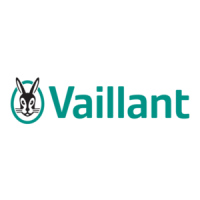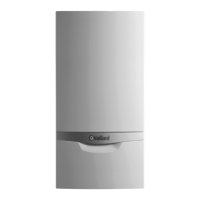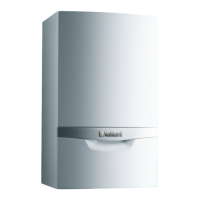
Do you have a question about the Vaillant VU GB 1206/5-5 and is the answer not in the manual?
| Type | Condensing Boiler |
|---|---|
| Fuel Type | Natural Gas |
| Mounting | Wall-mounted |
| Hot Water Function | Yes |
| Max. Water Temperature | 85°C |
| Nominal Heat Output | 12 kW |
| Output | 6.0 - 12.0 kW |
| Water Pressure | 1.0 - 3.0 bar |
Instructions for storing documents to ensure they are available when needed.
Lists the specific boiler models covered by these operating instructions.
Details the location and importance of the boiler's identification plate.
Explains the CE label, signifying compliance with basic requirements.
Highlights Vaillant's support for the Benchmark Initiative for boiler installation.
Guidance on observing safety information, warning signs, and their meanings.
Defines the boiler's intended purpose and user restrictions for safe operation.
Crucial safety instructions covering general operation, emergencies, and potential hazards.
Addresses specific risks like gas/flue gas leaks, scalding, corrosion, and frost.
Procedures for handling hot water leaks and maintaining adequate heating system pressure.
Guidelines for installation site requirements, and warnings against modifying the boiler or its components.
Illustrates the front view of the ecoTEC plus boiler and its key components.
Explains the primary functions of the boiler, including heating and hot water production.
Describes the process of heating water and circulating it through the heating system.
Explains how the boiler generates hot water, often with a cylinder.
Details how hot water is drawn and how the boiler reheats the cylinder.
Identifies and explains the main control elements of the ecoTEC plus boiler.
Introduces the DIA system for monitoring boiler status and displaying information.
Explains various symbols used on the boiler's display for status indication.
Details additional symbols related to operating modes and fault indicators.
Explains how to use the selector and +/- buttons to control the boiler's functions.
Describes the default display showing the boiler's current operating status.
Distinguishes between operator and competent person levels for accessing settings.
Steps for preparing the boiler for initial operation, including opening isolator devices.
Explains the procedure for opening boiler isolator devices, emphasizing competent person guidance.
Instructions on how to switch the boiler on and off using the main switch.
Guidance on checking and maintaining the correct water pressure in the heating installation.
Details the process of filling the heating installation with suitable water.
Instructions for adjusting the heating flow temperature with or without a controller.
Procedure for setting heating flow temperature based on outside conditions without a controller.
How to set heating flow temperature when using a room thermostat or weather compensator.
Covers hot water generation, including safety warnings and calcification prevention.
Instructions for adjusting the domestic hot water (DHW) temperature.
Guidance on setting room thermostats and weather compensators for heating control.
Explains how to disable specific functions like hot water generation or heating mode.
Details disabling cylinder charging while keeping heating mode active.
Instructions for turning off heating mode for summer while retaining hot water.
Safety precautions for temporarily shutting down the boiler, especially concerning frost.
Provides steps for completely switching off the boiler and related decommissioning notes.
Methods for protecting the heating system and boiler from frost damage.
Explains the boiler's frost protection function and its limitations.
Describes the process of draining the heating installation to prevent frost damage.
Explains how to interpret fault messages displayed on the boiler, including codes and plain text.
Details how fault codes (e.g., F.10) are displayed and explained.
Offers self-help by listing common problems, causes, and solutions for quick checks.
Addresses issues with low water pressure, its causes, and how to rectify them.
Explains how to resolve ignition failures, including error codes and manual reset.
Explains the service message indicator and the need for professional service.
Covers faults related to the fan and air/flue gas duct, including fault codes.
Guides on accessing and navigating the boiler's menu system using selector buttons.
Explains the hierarchical menu structure with selection levels and display fields.
Presents a visual overview of the menu structure and navigation paths.
Explains how to view the boiler's current operating status and associated messages.
Guides on adjusting the display contrast for optimal readability.
Details the procedure for changing the boiler's display language.
Emphasizes the importance of annual servicing for optimal performance and longevity.
Provides instructions on safely cleaning the boiler's exterior, warning against harsh agents.
Guidance on disposing of the boiler and accessories responsibly, avoiding household waste.
Recommends arranging for the installer to handle the disposal of transport packaging.
Details the two-year factory guarantee, including conditions for validation.
Explains the simple process for registering the guarantee to ensure coverage.
Provides contact information for immediate assistance and fault resolution.
Defines the controller as the interface for adjusting boiler settings and schedules.
Explains the frost protection function that prevents damage from freezing.
Describes vrnetDIALOG as an internet system for remote control and diagnostics.
Defines a weather compensator that adjusts heating based on outside temperature.











